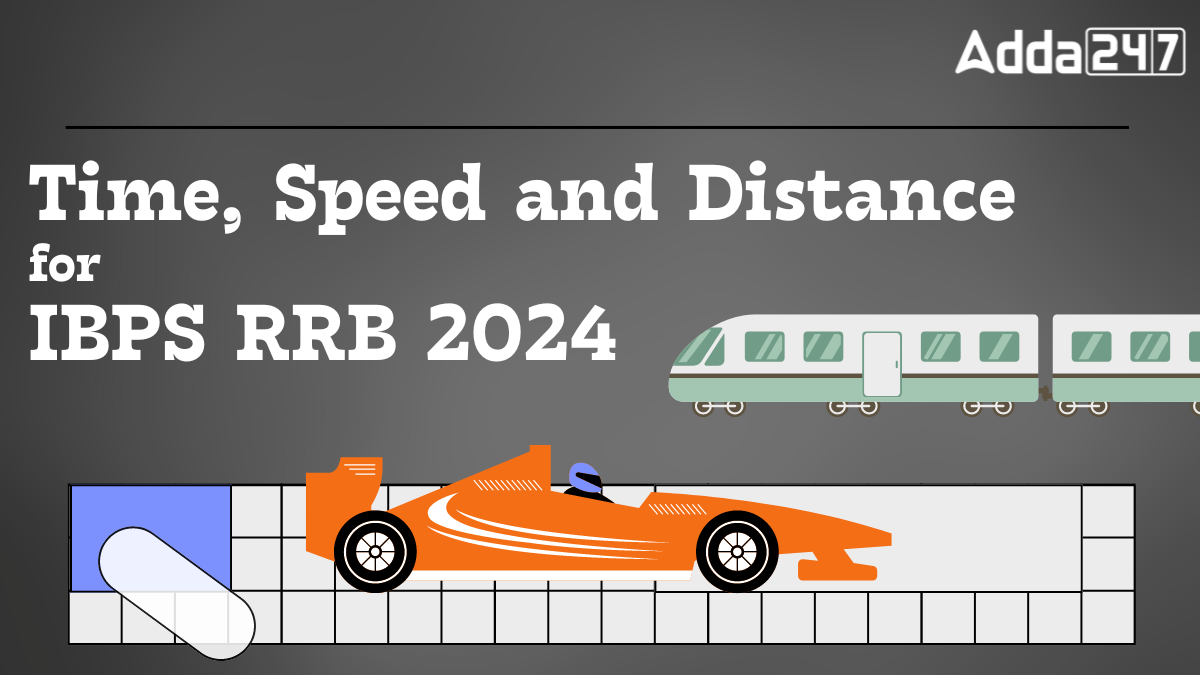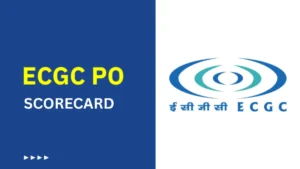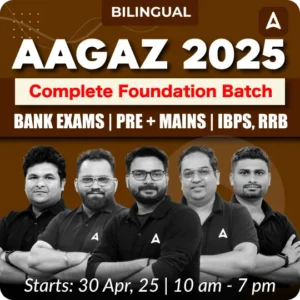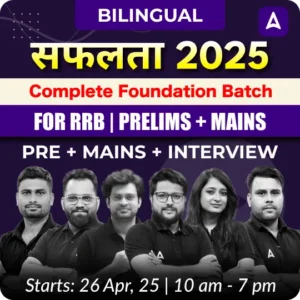Table of Contents
Time, Speed, and Distance, a crucial topic in the quantitative aptitude section of the IBPS RRB exam. Mastering this topic can significantly enhance the candidate’s performance and help them score better. This article will provide a detailed explanation of the concepts, important formulas, and a set of practice questions with solutions to help a candidate prepare effectively for the IBPS RRB 2024 exam.
Time Speed And Distance: Key Concept
01. Time, Speed, and Distance Relationship: The fundamental relationship between time, speed, and distance is given by the formula:
Distance = Speed x Time
From this, we can derive the other two equations:
- Speed = Distance / Time
- Time = Distance / Speed
02. Unit of Measurement
- Speed is usually measured in kilometres per hour (km/h) or meters per second (m/s).
- Distance is measured in kilometres (km) or meters (m).
- Time is measured in hours (h) or seconds (s).
Conversion Factors:
- 1 km/hr = 5/18 m/s
- 1 m/s = 18/5 km/hr
3. Average Speed: The average speed is calculated as the total distance travelled divided by the total time taken:
Average Speed = Total Distance / Total Time
4. Relative Speed
- When two objects are moving in the same direction, their relative speed is the difference between their speeds.
- When two objects are moving in opposite directions, their relative speed is the sum of their speeds.
Time Speed And Distance Important Questions For the IBPS RRB 2024 Exam
Q01. A ‘L’ meters long train cross a pole in ‘X’ sec and a platform which is 240 meters long in 40 sec. If speed of train is 36 km/hr, then what will be value of ‘X’?
(a) 20 sec
(b) 18 sec
(c) 16 sec
(d) 10 sec
(e) 12 sec
Q02. A train running at the speed of 144 km/hr crosses a man who running at 24 km/hr. in the same direction in 9 sec. If the train crosses a tunnel in 25.5 sec, then find the length of the tunnel?
(a) 780 meters
(b) 720 meters
(c) 480 meters
(d) 640 meters
(e) 440 meters
Q03. Train A crosses a man running in opposite direction in 16 seconds. Speed of man is 18 km/hr. and speed of train A is 72 km/hr.
Quantity I – Length of train A.
Quantity II – Length of train B, if train B, running at 162 km/hr. crosses train A in 40 seconds while running in same direction.
(a) Quantity I Quantity II
(b) Quantity I Quantity II
(c) Quantity I Quantity II
(d) Quantity I Quantity II
(e) Quantity I = Quantity II or no relation.
Q04. Vikash and Mohit started from point A towards point Q. Distance between A and Q is 9 km. If Mohit starts after 4 min., then he will meet Vikash 1 km away from point Q at a time when Vikash is returning towards point A after reaching point Q and Vikash can cover 1 km in 6 min. find speed of Mohit in km/min.
(a) 1/7
(b) 1/8
(c) 1/9
(d) 1/6
(e) 1/12
Q05. Train P and Q are running at the speed of ‘S’ km/hr and (S + 36) km/hr respectively. When both trains running in the same direction, crosses each other in seconds, while when both trains running in the opposite direction, crosses each other in seconds.
Quantity I – Sum of speed of both trains (in km/hr).
Quantity II – 126 km/hr
(a) Quantity I = Quantity II or no relation
(b) Quantity I < Quantity II
(c) Quantity I ≥ Quantity II
(d) Quantity I > Quantity II
(e) Quantity I ≤ Quantity II
Q6. In eleven hours C walks 12.5 km less than what D does in twelve h; and in five h D walks 3.25 km less than what C does in seven h. How many km does each walk per hour ?
(a) 3 and 4
(b) 3.5 and 4.25
(c) 2.33 and 3.4
(d) 4 and 5
(e) None of these
Q7. A train 75 meters long overtook a person who was walking at the speed of 6 km/h in the opposite direction and passed him in 7 1/2s. Subsequently, it overtook a second person, walking in the same direction as the first person and passed him in 6 3/4 s. At what rate was the second person travelling ?
(a) 11.75 km/hr
(b) 10 km/hr
(c) 8 km/hr
(d) 4.5 km/hr
(e) None of these
Q8. Shramjeevi Express leaves Patna for New Delhi at 10 : 10 am and reaches New Delhi at 3 : 30 pm. Magadh Express leaves New Delhi at 9 : 48 am and reaches Patna at 2 : 36 pm. If routes of both the trains are the same, then at what time will both the trains meet each other ?
(a) 12 : 52 pm
(b) 1 : 12 pm
(c) 1 : 32 pm
(d) Can’t be determined
(e) None of these
Q9. Preeti and Uma stay next to each other and study in the same school. Preeti and Uma start walking towards their school at the speed of 2 km/hr and 3 km/hr respectively. The faster of the two reaches the school first, turns around and starts walking back. If Preeti and Uma meet 200 m away from the home, what is the distance between their residence and the school ?
(a) 260 m
(b) 240 m
(c) 200 m
(d) 250 m
(e) None of these
Q10. A car after travelling a distance of 110 km develops a problem in the engine and proceeds at ¾ th of its former speed and arrives at the destination 60 minutes late. Had the problem developed 30 km further on, the car would have arrived 12 minutes sooner. Find the original speed of the car.
(a) 45 km/hr
(b) 60 km/hr
(c) 50 km/hr
(d) 55 km/hr
(e) None of these
Q11. P and Q start running simultaneously—one from point A to B and second from point B to A. P’s speed is 6/5th of Q’s speed. If after crossing Q, P takes 2 1/2hours to reach B, how much time does Q take to reach A after crossing P ?
(a) 3 : 36 minutes
(b) 3 : 48 minutes
(c) 4 : 12 minutes
(d) 4 : 24 minutes
(e) None of these
Q12. Vinod and Kaurvaki start travelling in the same direction at 8 km/hr and 13 km/hr respectively. After 4 hours, Vinod doubled his speed and Kaurvaki reduced his speed by 1 km/hr and reached the destination together. How long did the entire journey last ?
(a) 3 h
(b) 6 h
(c) 9 h
(d) 12 h
(e) None of these
Q13. The number expressing (in metres) the length of a fast and a slow trains are three times the numbers expressing (in km/hr) the speed of the slow and the fast train respectively. The speed of the slow trains and that of the fast train consists of the same two digits, but in a reverse order. The time taken by the two trains to pass each other, when traveling in an opposite direction on parallel lines will be
(a) 10.8 s
(b) 5.4 s
(c) 9.77 s
(d) 5.18 s
(e) None of these
Q14. A beats B by 20 m in a 100 m race and B beats C by 20 m in a 100 m race. How much start should A give to C in a 100 m race so that both of them reach the winning post at the same time ?
(a) 30 m
(b) 44 m
(c) 32 m
(d) 36m
(e) None of these
| Solutions | ||||
| 01 | 02 | 03 | 04 | 05 |
| c | b | a | a | a |




 GA Capsule for SBI Clerk Mains 2025, Dow...
GA Capsule for SBI Clerk Mains 2025, Dow...
 The Hindu Review October 2022: Download ...
The Hindu Review October 2022: Download ...
 ECGC PO Scorecard 2025 Out, Check Marks
ECGC PO Scorecard 2025 Out, Check Marks



